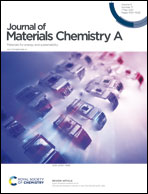Core-corona Co/CoP clusters strung on carbon nanotubes as a Schottky catalyst for glucose oxidation assisted H2 production†
Abstract
The simultaneous improvement of intrinsic activities and the number of active sites in electrocatalysts is the bottle-neck issue for H2 production. Herein, commercial CNTs serving as conductive kernels are in situ coupled with 3D ZIF-67 derived Co/CoP core-corona clusters. Such a hierarchical bead string nanostructure not only possesses highly exposed active sites, but also favours fast electron transfer for electrocatalytic kinetics. Our material shows excellent HER (η10 = −151 mV) and glucose oxidation reaction (GOR) performance, showing a smaller hybrid water splitting potential of 1.42 V compared to conventional water splitting (η10 = 1.74 V) for H2 production. DFT calculations indicate that the Schottky heterointerface at Co/CoP decreases the initial H2O dissociation energy barrier and possesses a thermoneutral H* adsorption free energy for the HER, as well as reducing the energy barrier for the GOR. Meanwhile, more oxidative cobalt oxyhydroxide favoured the GOR process. The present work opens a new avenue for designing Mott–Schottky multifunctional electrocatalysts for both energy-saving H2 production and value-added products.



 Please wait while we load your content...
Please wait while we load your content...